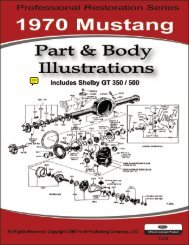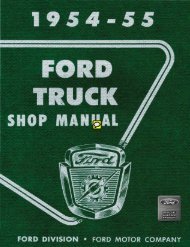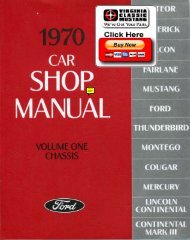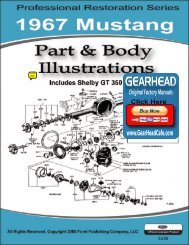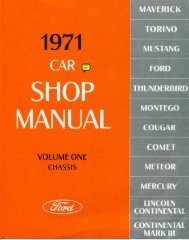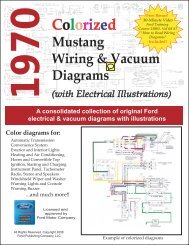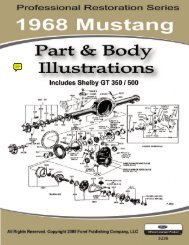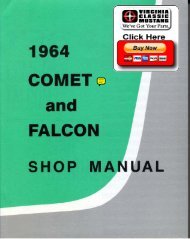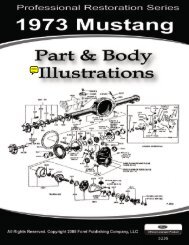DEMO - 1959 Ford Thunderbird Shop Manual - ForelPublishing.com
DEMO - 1959 Ford Thunderbird Shop Manual - ForelPublishing.com
DEMO - 1959 Ford Thunderbird Shop Manual - ForelPublishing.com
You also want an ePaper? Increase the reach of your titles
YUMPU automatically turns print PDFs into web optimized ePapers that Google loves.
PART 1-1 -GENERAL ENGINE SERVICE<br />
Ml<br />
and the choke plate in the wide open<br />
position.<br />
3. Install a <strong>com</strong>pression gauge in<br />
No. 1 cylinder.<br />
4. Crank the engine several times<br />
and record the highest reading reg<br />
istered. Note the number of <strong>com</strong>pres<br />
sion strokes required to obtain the<br />
highest reading.<br />
5. Repeat the test on each cylin<br />
der, cranking the engine the same<br />
number of times for each cylinder<br />
as was required to obtain the highest<br />
reading on No. 1 cylinder.<br />
TEST CONCLUSIONS<br />
A variation of 20 pounds from<br />
specified pressure is satisfactory.<br />
However, the <strong>com</strong>pression of all cyl<br />
inders should be uniform within 10<br />
pounds.<br />
A reading of more than the allow<br />
able tolerance above normal indicates<br />
excessive deposits in the cylinder.<br />
A reading of more than the allow<br />
able tolerance below normal indicates<br />
leakage at the cylinder head gasket,<br />
piston rings, or valves.<br />
A low even <strong>com</strong>pression in two<br />
adjacent cylinders indicates a cylin<br />
der head gasket leak. This should be<br />
checked before condemning the rings<br />
or valves.<br />
To determine whether the rings<br />
or the valves are at fault, squirt the<br />
equivalent of a tablespoon of heavy<br />
TABLE 3 Manifold Vacuum Gauge Readings<br />
Gauge Reading<br />
19-20 inches (352 engine).<br />
17-18 inches (430 engine).<br />
Low and steady.<br />
Very low.<br />
Needle fluctuates steadily<br />
as<br />
speed increases.<br />
Gradual drop in reading at<br />
engine idle.<br />
Intermittent fluctuation.<br />
Slow fluctuation or drifting<br />
of the needle.<br />
oil into the <strong>com</strong>bustion chamber, then<br />
crank the engine to distribute the oil<br />
and repeat the <strong>com</strong>pression test. The<br />
oil will temporarily<br />
seal leakage past<br />
the rings. If approximately the same<br />
reading is obtained, the rings are<br />
Normal.<br />
Engine Condition<br />
Loss of power in all cylinders caused possibly<br />
by late ignition or valve timing, or loss of<br />
<strong>com</strong>pression due to leakage around the piston<br />
rings.<br />
satisfactory, but the valves are leak<br />
ing. If the <strong>com</strong>pression has increased<br />
10 pounds or more over the original<br />
Manifold, carburetor, or cylinder head gasket<br />
leak.<br />
A partial or <strong>com</strong>plete loss of power in one or<br />
more cylinders caused by a leaking valve, cyl<br />
inder head or intake manifold gasket leak, a<br />
defect in the ignition system, or a weak valve<br />
spring.<br />
Excessive back pressure in the exhaust system.<br />
An occasional loss of power possibly caused<br />
by a defect in the ignition system or a sticking<br />
valve.<br />
Improper idle mixture adjustment, carburetor<br />
or intake manifold gasket leak, or possibly<br />
late valve timing.<br />
reading, there is leakage past the<br />
rings.<br />
During a <strong>com</strong>pression test, if the<br />
pressure fails to climb steadily and<br />
remains the same during the first two<br />
successive strokes, but climbs higher<br />
on the succeeding strokes, or fails<br />
to climb during the entire test, it in<br />
dicates a sticking or stuck valve.<br />
CLEANING, INSPECTION, AND RECONDITIONING<br />
INTAKE MANIFOLD<br />
Clean the manifolds in a suitable<br />
solvent, then dry<br />
pressed air.<br />
them with <strong>com</strong><br />
On the 352 engine, scrape all car<br />
bon deposits from the center exhaust<br />
passage below the carburetor heat<br />
riser. This carbon acts as an insu<br />
lator restricting the heating action of<br />
the hot exhaust gases.<br />
Inspect the manifold for cracks,<br />
leaks, or other defects that would<br />
make it unfit for further service. Re<br />
place all studs that are stripped or<br />
otherwise damaged. Remove all fil<br />
ings and foreign matter that may have<br />
entered the manifold as a result of<br />
repairs.<br />
On the 352 engine, check the baffle<br />
plate on the underside of the mani<br />
fold for looseness and be sure the<br />
maze screen is in place. Clean off<br />
any<br />
varnish accumulation.<br />
EXHAUST MANIFOLD<br />
Inspect the manifolds for cracks,<br />
leaks, or other defects that would<br />
make them unfit for further service.<br />
On the right exhaust manifold of<br />
the 352 engine, clean out the auto<br />
AIR INLET'<br />
matic choke air heat chamber (Fig.<br />
3). Make sure the air inlet and outlet<br />
holes are <strong>com</strong>pletely open and the<br />
cover does not leak. Blow out the<br />
1S09-A<br />
FIG. 3 Automatic Choke Air Heat Chamber 352<br />
Engine




